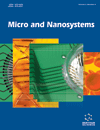-
oa EDITORIAL [Hot topic: Future Emerging Technologies in Microelectronics (Guest Editor:Balazs Illes)]
- Source: Micro and Nanosystems, Volume 2, Issue 3, Sep 2010, p. 142 - 142
-
- 01 Sep 2010
- Previous Article
- Table of Contents
- Next Article
Abstract
Microelectronics is one of the most rapidly progressing fields of engineering science. This multidisciplinary field of science which is prevalent in everyday life. Each year completely new innovations in microelectronics appear in the market which immediately become an important and indispensable part of our life. These innovations increasingly demand precise, fast and cheap production technologies. The aim of this special issue is to give a short overview of the latest research in microelectronics applications and technologies which will lead to new innovations in the near future. Most of the corresponding authors of this special issue are researchers in the Department of Electronics Technology at Budapest University of Technology and Economics. The researchers participate in international R&D projects sponsored by the European Union (LeadOut, Felxnolead, μBuilder, EMCI) and collaborate with numerous industrial partners (Bosch, Nokia, Elcoteq, Felxtronics). This hot topic specifically focuses on microelectronics engineering in the following domains: • using contact mode Atomic Force Microscopy (AFM) for qualification of AgPd thick films and detecting very small concentration of surface contaminants; • optimizing the illumination of Automatic Optical Inspection (AOI) appliances for quasi-tombstone detection of chip size components after reflow soldering; • investigating the level differences on the deposited solder paste area by 3D structured white light measurements and FEM simulations; • developing an experimental Vapor Phase Soldering (VPS) station to improve the knowledge about vapor generation, progression and condensation processes; • examining the thickness evolution of Sn-Cu intermetallic compounds (IMCs) in laser reflowed solder joints; • developing a method which is based on the graph theory to describe the heat conduction ability of big Surface Mounted Devices (SMDs) during the reflow soldering process. The problems addressed by the papers reflect on the major trends and results in modern engineering science which are chiefly engaged with: (i) atomic microscopy in quality control (ii) automatic optical inspection; (iii) innovations in stencil printing; (iv) developments in laser and vapor phase soldering; (v) application of new mathematical methods in soldering simulations. These topics may further serve the interest of the readers of Micro and Nanosystems in sensing devices for medical and other applications as well as having broader utility.


